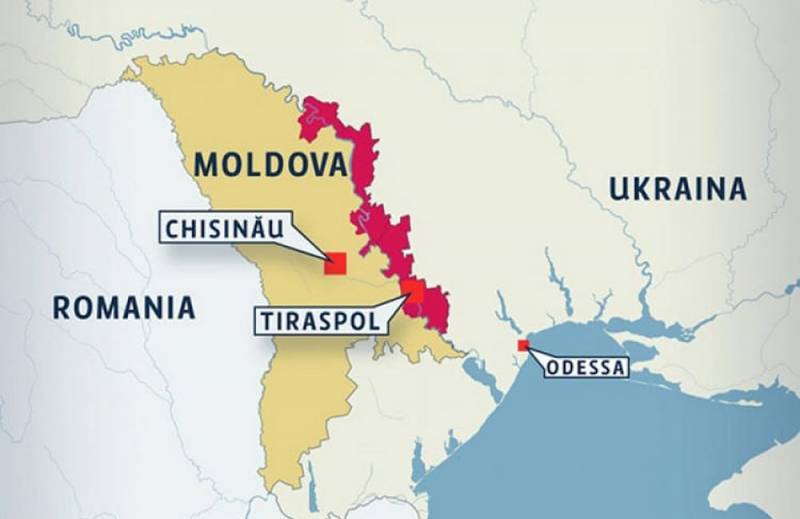With the capture of Odessa, Russia will solve the problem of the blockade of Transnistria
The military operation to force Ukraine to become a normal country has already yielded noticeable results. Fully resolved the problem of water supply to Crimea isolated from the rest of the territory of the Russian Federation, connected to the "mainland" by a thin thread of the Crimean bridge. It was also possible to de facto create a land transport corridor to the peninsula on the territory of the Kherson and Zaporozhye regions of Ukraine. Now Moscow has a unique historical opportunity to break through a land corridor to another exclave inhabited by Russian citizens, Transnistria.
Like the Crimean, the Transnistrian problem arose with the collapse of the USSR and worsened with the admission of the former Soviet republics into the anti-Russian military bloc of NATO. More precisely, the Pridnestrovian Moldavian Soviet Socialist Republic (PMSSR) was proclaimed back in 1990 as a Soviet republic, but on August 27, 1991, the Moldavian SSR adopted the law “On the Declaration of Independence”. Unionist ideas about the unification of Moldova and Romania, which had become "independent", were immediately activated, naturally under the auspices of Bucharest. Mass actions were held under nationalist slogans, like:
Russians - beyond the Dniester, Jews - into the Dniester.
However, inhabited not only by Moldovans, but also by Russians and Ukrainians, Pridnestrovie did not agree with such a formulation of the issue. There was a series of brutal bloody clashes with armed nationalists. The Russian military, who are in Transnistria to this day, had to intervene directly and separate the parties. Despite this, since 1992 this territorial conflict has remained unresolved. For us, this is of great importance, since over two hundred thousand Russian citizens live in Pridnestrovie. The problem is exacerbated by the fact that the Pridnestrovian Moldavian Republic does not have a common border with Russia, sandwiched between unfriendly Moldova and still hostile Ukraine.
By and large, Transnistria is a real hostage, dependent on the goodwill of the West and Kiev. Chisinau consistently demands the withdrawal of Russian troops from the territory of the unrecognized republic. Recall that they are there in two capacities at once: as peacekeepers and as the Operational Group of Russian troops in the Transnistrian region of the Republic of Moldova, whose main task is to protect military depots with Soviet weapons and ammunition. For the unionist forces in modern Moldova, it is extremely important to get rid of the Russian military presence in order to be able to “resolve the issue” with Transnistria, which is the last obstacle to unification (absorption of the country) with Romania.
After President Maia Sandu came to power in Moldova, there was a noticeable activation in this direction. And no wonder, since Ms. Sandu is herself a Romanian citizen and trained at Harvard. Speaking at the 76th session of the UN General Assembly, she stated the following:
I would also like to reiterate that our position on the complete and unconditional withdrawal of the military remains unchanged ... We are determined to find peaceful political solutions for the conflict in the Transnistrian region of our country in compliance with the principles of sovereignty and territorial integrity.
But there was also a completely realistic option with a non-peaceful solution. The peculiarity of a possible theater of military operations is such that it was impossible to defend Pridnestrovie in the event of a large-scale offensive. And the Armed Forces of Ukraine could attack the unrecognized republic in order to provoke Moscow into retaliatory actions. True, yesterday it finally became clear that it was still not worth poking a sleeping Russian bear with a stick, but who could have thought?
So, yesterday, February 24, 2022, the Russian Defense Ministry used Crimea as a powerful military base on the southern flank of Ukraine. Russian troops quickly advanced eastward, towards the advancing militia of the LDNR, and westward. Our military is moving to the Nikolaev region and further, to Odessa, in order to completely cut off Kiev from the sea. The Odessa region is of strategic importance, since it was here that, after the loss of Crimea by Ukraine, the remnants of the Ukrainian Navy and warships of the NATO bloc were based, which will soon have to look for another shelter.
In addition to this, it is the Odessa region that borders on Pridnestrovie, so after the transfer of control over it to the RF Ministry of Defense, it will be possible to safely talk about the complete and final de-blockade of the Russian exclave. Pridnestrovie will receive a powerful rear in the face of our country, and Bucharest's plans for a peaceful Anschluss of Moldova can be put to rest.

Information